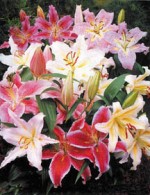
As spring approaches many stores are carrying a variety of summer flowering bulbs. Many of them are not bulbs at all but have parts that resemble them called corms, rhizomes, or tubers. Many are tropical and therefore not hardy so must be dug and stored for next year’s bloom or replaced with new bulbs each spring. They are all showy and well worth the trouble or expense of growing them. Plant in well-drained soil to avoid rot unless otherwise noted. When selecting bulbs, buy only those that are firm and have no signs of rot.
For full sun
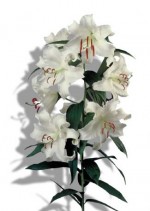
Oriental or Asiatic Lilies
These are true lilies, unrelated to daylilies, and are grown from true bulbs. They are hardy in zone 4/5-8 and produce large showy flowers that are also fabulous in arrangements. They come in many colors including red, orange, pink, white, gold, and lemon yellow. The oriental lily hybrids ‘Stargazer’ and ‘Casa Blanca’ are frequently found in florist bouquets. Favorite Asiatic lilies include orange ‘Enchantment’, yellow ‘Connecticut King’, and dark red ‘Black Beauty’. Bulbs dry out quickly so should be planted very promptly .
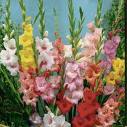
Gladiolus
The long spikes of gladiolus flowers are a beautiful sight in the garden or in a vase. Plants may be from 1’ to 7’ tall and are of many colors including green. Many have flowers with colorful streaks and blotches and wavy, frilly, or crimped edges. By spacing out the planting time of the corms, a succession of flowers may be achieved. Tall varieties are striking when massed at the back of the border while small varieties are charming at the front or middle of the border. Since they are hardy only in zone 8 and warmer, they must be lifted in or replaced.
Dahlias
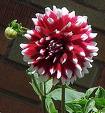
Dahlias come in a great variety of sizes, forms, and colors. They may be short (1’) or tall (8’) and any size in between. Flowers may be solid colored, streaked, or bicolored, and range in size from a few inches to 1’. Some are composed of a single row of petals, others with so many petals they form a mound. They provide color in the garden from mid summer to frost and are good cut flowers. Unfortunately they are not hardy in zones 7 and colder so must be lifted in the fall or replaced.

Cannas
Tall (8’) or short(2’) cannas make an impact in the garden due to their bold leaves and upright stature. The flowers may be red, yellow, orange or a combination of these and some have dark purple or yellow variegated foliage. They are wonderful plants for the back of the border and will multiple quickly under good growing conditions. They are said to hardy only in zones 8 to 10 but the cannas in my two zone 7 gardens have had no trouble surviving through the coldest winters there without mulch or any special treatment.
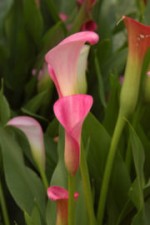
Calla lily
Calla lilies have a very unusual flower consisting of a white, yellow, pink or brown wrap-around spathe and pencil -like yellow spadix. They vary in hardiness as well as in color and size and do well in sun or partial shade. They can even grow well in wet soil. As a bonus they are excellent for vase arrangements and are often used in bridal bouquets. Check the label on any plant you buy to determine hardiness. Calla lilies will lake some shade.
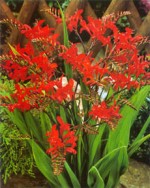
Crocosmia/Montbretia
This is one great fabulous plant especially if you like hummingbirds. But watch out, it can become invasive in good growing conditions. They thrive in zones 5-9 in moist soil and earn their keep throughout the growing season in the back of the border with their long, sword like foliage that provides a good backdrop for shorter plants. ‘Lucifer’ is scarlet but other varieties are available in yellow, maroon, and bicolors. Varieties may be 2-4 feet.

Agapanthus
These produce a large clusters of blue or white flowers on 2’-4’ stems. The clumps of long shiny strap shaped leaves are attractive even when the plants are not in bloom. There are several varieties available and some are hardy in zones 7-10; others only in zones 9-10 so check the information that comes with your plant when you buy it. In hot climates Agapanthus can take some shade. Agapanthus flowers are prized by florists and make a smashing presence in a bouquet.

Peacock Orchid (Gladiolus callianthus)
The fragrant pure white flowers have purple markings in their throat and are born from clumps of thin sword like foliage that reach 18”-24”. Hardy in zones 7-10.
For Shade

Caladium
If you need to have color in a shaded area, plant caladiums. Their large bold colorful leaves born on 1’ high stems may be green and red, green and white, spotted or streaked green, white veined with pink, red or green, and many other variations of green, red, and white. They are very cold sensitive and should not be planted out until the soil has warmed up to 75 degrees. They must be stored at temperatures over 70 degrees during the winter or replaced.
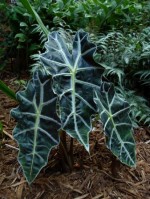
Elephant Ear (Colocasia esculenta)
Grown for its bold, heart shaped foliage, Elephant ear gives a tropical look to any garden. It is a tall plant (8’ in warm climates) and will survive winters in zones 8-10. Many varieties are available including ones that appears black, another that is black with white veining, another that is yellow variegated. These plants love water and can be grown successfully in wet soil.
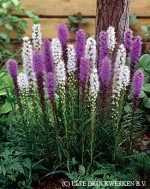
Liatris (Gayfeather)
Erect 1.5’ to 5’ stems of rosy purple or white flowers with fine grass green foliage make a nice vertical accent in the border. Liatris is hardy in zones 3-10 and will take considerable sun. The straight flowering stems of liatris make a strong vertical accent in flower arrangements and are commonly used by florists.
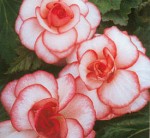
Tuberous begonia
For romantic, full, fluffy flowers you can’t beat tuberous begonias. The single or double flowers come in red, orange, salmon, pink, and white on upright or trailing stems. The petals may be frilled, fringed or plain and some are tipped with a contrasting flower. Tuberous begonias do will in dappled shade but can take some morning or late afternoon sun. Hardy only in zone 10, they must be protected in the winter or replaced.
